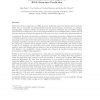Free Online Productivity Tools
i2Speak
i2Symbol
i2OCR
iTex2Img
iWeb2Print
iWeb2Shot
i2Type
iPdf2Split
iPdf2Merge
i2Bopomofo
i2Arabic
i2Style
i2Image
i2PDF
iLatex2Rtf
Sci2ools
207
Voted
RECOMB
2011
Springer
2011
Springer
Rich Parameterization Improves RNA Structure Prediction
Motivation. Current approaches to RNA structure prediction range from physics-based methods, which rely on thousands of experimentally-measured thermodynamic parameters, to machinelearning (ML) techniques. While the methods for parameter estimation are successfully shifting toward ML-based approaches, the model parameterizations so far remained fairly constant and all models to date have relatively few parameters. We propose a move to much richer parameterizations. Contribution. We study the potential contribution of increasing the amount of information utilized by folding prediction models to the improvement of their prediction quality. This is achieved by proposing novel models, which reļ¬ne previous ones by examining more types of structural elements, and larger sequential contexts for these elements. We argue that with suitable learning techniques, not being tied to features whose weights could be determined experimentally, and having a large enough set of examples, one could deļ...
Computational Biology | Feature Representations | Ml Techniques | RECOMB 2011 | Rna Structure Prediction |
Related Content
| Added | 17 Sep 2011 |
| Updated | 17 Sep 2011 |
| Type | Journal |
| Year | 2011 |
| Where | RECOMB |
| Authors | Shay Zakov, Yoav Goldberg, Michael Elhadad, Michal Ziv-Ukelson |
Comments (0)

